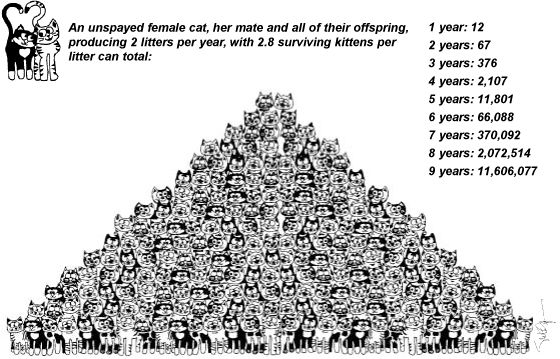February is Spay & Neuter Awareness Month. Have your dogs and cats been spayed and neutered? Bob Barker was right, to help control the pet population it’s important to have your pet spayed or neutered. There’s no better way to ensure Fido and Felix aren’t out carousing and littering the town with, well, litters.
If you’ve already taken care of getting your dog or cat spayed or neutered – kudos. If not, what are you waiting for? What’s keeping you from getting it done?
Simple Explanation
The basic definition of spay and neuter is a great place to start. Female dogs and cats are spayed by removing their reproductive organs; male dogs and cats are neutered by removing their testicles. The operation for both dogs and cats is performed while the pet is under anesthesia. Your veterinarian may want to keep your dog under observation for anywhere from a few hours to several days. Your pet will have to return in a week to ten days for suture removal.
Common Misconceptions
Turns out, there are a lot of misconceptions about spaying and neutering that probably scare people away from getting this important procedure done for their pets. As a responsible pet owner it’s important that you do your best to understand the procedures and clear your mind of the misconceptions that have been floating around for years.
- I’ve heard it’s better to let her have a litter, first
Maybe you think before spaying a female pet it’s better to let her have a litter. Quite the opposite is indicated in medical evidence. The evidence shows that females spayed before their first heat are typically healthier. The early spaying also reduces the incidences of mammary cancer. And consider the fat that it’s possible for animals to die from complications of giving birth, not to mention how stressful the pregnancy and birth can actually be on your pet. - I want my dog to be protective
Sex hormones do not form a dog’s personality. Genetics and environment play a much bigger part of their personality. A dog’s natural instinct is to protect home and family. If he was a good watchdog and protective before the surgery he will remain a good watchdog and protective. - My pet will get fat and lazy
There can be a tendency for an animal to put on some weight after sterilization, however the condition is not caused by the surgery. Male dogs and cats will roam around less – thus burning fewer calories. The fact is, most pets get fat and lazy because their owners feed them too much and don’t provide them with enough exercise. All the more reason to get out and walk your pet – or play ball – or provide some entertaining (calorie-burning) activity. - My pet is a purebred
That doesn’t mean your pet’s puppies or kittens won’t end up in an animal shelter. According to the HSUS, an estimated 25 percent of dogs in shelters are purebred. And remember, about half of all animals entering shelters are euthanized. - We don’t need to neuter because males aren’t having the litters
This misconception is the most prevalent and yet the most outrageous. It takes two to tango and immaculate conception doesn’t happen in canine and feline pregnancies. Both animal participants are responsible, just the same as with humans. - I don’t want my male dog or cat to feel less ‘manly’
Your neutered male pet will not suffer an emotional reaction or identity crisis. Their basic personality will not be altered since they have no concept of sexual identity or ego. If it bothers you too much, you can check out this method or even look into neuticles (though plastic surgery for pets is a tad on the crazy side). Fido’s pride isn’t tied to his balls. - I think it’s important for my children to see the miracle of birth
If your pet is pregnant and the children are lucky enough to see the birth of baby animals first hand it can certainly be an event that will perhaps teach them just how precious life is. Catching the event will not be easy because when pets are ready to have the litter they usually go off by themselves. And it often happens in the middle of the night. But to allow your pet to give birth just for the sake of the children experiencing the event? Shame on you! There are more humane ways available to educate your children in this day and age. National geographic has wonderful programs and videos about the pregnancy and birth of animals. - The surgery is dangerous and/or painful
The surgeries are quite quick, very safe, and the most routine procedure performed in the veterinary world. Within a few hours of the surgery pets are awake, alert, walking and eating. As long as owners follow all post-surgical instructions, complications are rare. Pain medication is prescribed after surgery to be used as needed. - It’s just unnatural to prevent pets from having litters
Unnatural was humans domesticating dogs 15,000 years ago and cats 8,000 years ago. We interfered with nature and helped create the problem of overpopulation. What is more unnatural than preventing our pets from having a litter is killing so many unwanted pets in the pounds and shelters. - We can find good homes for all the puppies/kittens
Finding homes for kittens and puppies can indeed be quite easy. But what happens when they are no longer cute little kittens and puppies? Are you sure every home you placed that pet into will continue to love and care for them, or will they end up at an animal shelter. Are you willing to take that risk? It’s a gamble you can avoid by not contributing to the ever-growing pet overpopulation problem in the first place. - The cost of having my pet spayed/neutered is just too expensive
Compared to what? The expense of caring for one litter of puppies or kittens will be a whole lot more than the one-time cost of this important surgery. In the U.S. there’s at least one spay/neuter clinic within driving distance of your home that charges $100 or less for the procedure. During the month of February, to grow awareness of the importance for spaying and neutering, the low-cost offers are abundant. Check out this low-cost spay/neuter finder or locate an affordable spay/neuter clinic here.
The Stats
Millions of healthy, adoptable cats and dogs are euthanized each year in the U.S. because there simply are not enough homes for them all. Last year, over 15 millions dogs and cats were killed in the US – and that doesn’t include the many pets who were thrown out of cars, left by the side of the road, or dropped off in woods or fields left to fend for themselves. Yet, we can’t kill the misconceptions that are perpetuating their destruction. For every puppy and kitten brought into the world by a well-meaning owner, another will die somewhere else, unwanted and homeless.
How Overpopulation Happens
Having a cat or dog who isn’t spayed or neutered doesn’t seem like a big deal, right? Let’s consider Miss Smith who owns a male cat named Tom. Tom’s a great cat, a perfect pet, and Miss Smith provides awesome care for his well-being – but doesn’t get him neutered because she doesn’t want to put him through that. Tom occasionally hooks up with stray cats in heat. Let’s be conservative and say that Tom is responsible for helping 2 litters of kittens enter the world every year and that the litters average 2 surviving kittens (even though we know there are likely more per litter). In five years, Tom’s got 20 kittens floating around that Miss Smith isn’t even aware of.
But the real problem is, those kittens grow up and start having their own litters:

Quite an eye-opener. We’re not sure who originally created the image, but it’s a perfect representation of the pet overpopulation problem. Female cats can breed three times a year and have an average of four kittens per litter. Dogs can breed twice a year and have an average of 6 – 10 puppies per litter. Female cats can breed as early as four months and dogs as early as six months! Imagine the pyramids to put overpopulation into perspective. The sad fact is, many of the new litters end up being euthanized.
World Spay Day – Feb 26
 The Humane Society of the United States and Humane Society International will hold the 19th annual World Spay Day on February 26, 2013. During the month, events will be held to raise money to provide low and no cost spaying/neutering, educational programs, and clinics.
The Humane Society of the United States and Humane Society International will hold the 19th annual World Spay Day on February 26, 2013. During the month, events will be held to raise money to provide low and no cost spaying/neutering, educational programs, and clinics.
The Doris Day Animal Foundation, the ASPCA®, the House Rabbit Society, Humane Alliance, the Humane Society Veterinary Medical Association, Petfinder, and PetSmart Charities® serve as proud partners.
Hundreds of animal welfare organizations, veterinary clinics and hospitals, schools, businesses, and individuals in the United States and around the world organize World Spay Day events to educate people in their communities about the life-saving importance of spay/neuter, to provide spay/neuter services at special prices for particular populations, and to raise critical spay/neuter funds.
When’s Best to Spay/Neuter?
 The question isn’t just whether to spay or neuter, but when to spay or neuter.
The question isn’t just whether to spay or neuter, but when to spay or neuter.
Fix at Four is a spay and neuter education initiative from BestFriends aimed at creating awareness of the proper age at which dogs and cats should be spayed or neutered, recommending four months is old enough. There’s still controversy over pediatric neutering. Below are a couple of sources that might be able to help you decide:
- For detailed information, the American Veterinary Medical Association has an excellent article available. Read “Determining the optimal age for gonadectomy of dogs and cats” to find the answers to your questions.
- The American Animal Hospital Association supports the concept of neutering cats and dogs as young as 8 weeks of age in order to help reduce the overpopulation problems in companion animals.
So what are you waiting for?
This is PetsBlogs, reminding you to help control the pet population.
Have your pet Bob Barker’d. 🙂
IF you grew up watching the Price is Right, check out this video – very interesting!





3 Comments
I couldn’t agree more. I just spayed my little one, not because it’s the law, but there are too many dogs out there without homes. We need to control the population, so our dogs aren’t homeless. Even though, there are plenty of people in the world to rescue all the dogs, there just aren’t enough “dog” people.
The number of dogs and cats euthanized each year should be enough incentive to spay and neuter. For me, the only question is when to do it. Healthwise, I believe it is best for the pet to physically mature (about 1 year or a little more), certainly for the growth plates to close. However, I understand that this creates greater risk for an unplanned litter. I am opposed to pediatric neutering for health reasons.
Ditto on the age choice, Kristin. I’m waiting for my pup to turn a year old before I have him neutered. Just seems better than ‘pediatric’ neutering, all things considered.